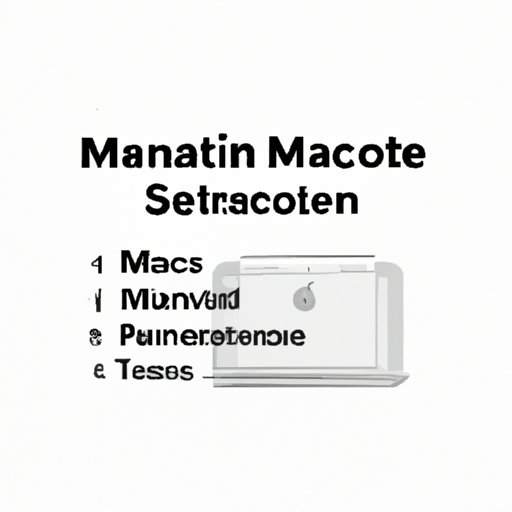Introduction
Mac users may need to uninstall programs for several reasons, whether it’s due to freeing up disk space, troubleshooting issues, or simply cleaning up their system. However, for those who are not familiar with the Mac environment, uninstalling programs can be a daunting task. This article presents a step-by-step guide on how to uninstall programs on Mac while optimizing your system’s performance. Whether you are new to Mac or a seasoned user, this article is for you.
Step-by-Step Guide
To start, let’s go over the basics: accessing the Applications folder. The Applications folder can be accessed via the Dock or by going to Finder > Applications.
To uninstall a program, simply drag the program’s icon from the Applications folder to the Trash bin, located at the end of the Dock. Alternatively, right-click on the program’s icon and select Move to Trash. Once the program is in the Trash bin, right-click on the bin and select Empty Trash to permanently delete the program from your system.
It’s important to note that not all programs are located in the Applications folder. Some system apps, for instance, are found in other folders. To uninstall system apps or programs that don’t have an uninstall option, you can either use Terminal commands (as we’ll cover later), or consider using third-party apps.
If you need to uninstall several programs at once, you can select multiple icons in the Applications folder, right-click, and select Move to Trash. The programs will be moved to the Trash bin all at once, and you can then empty the bin as usual.
Video Tutorial
While the step-by-step guide is useful in itself, some people might prefer a visual approach to learning how to uninstall programs on Mac. That’s where video tutorials come in handy.
Video tutorials offer a more interactive and hands-on approach to learning. Seeing the process in action can make the steps easier to understand and follow. If you prefer this method, we’ve got you covered: watch our video tutorial on how to uninstall programs on Mac.
The video covers the same steps as the step-by-step guide above, but includes visual aids and a more detailed look at each step.
Using Terminal Commands
For some programs, dragging the icon to the Trash bin may not be enough to fully remove the program from your system. In these cases, Terminal commands can be used.
Terminal is a command-line interface that allows you to control your Mac using text commands. To access Terminal, open Finder and go to Applications > Utilities > Terminal.
Once Terminal is open, you can use a few simple commands to uninstall a program. For example, to uninstall Google Chrome, type the following command:
sudo rm -rf /Applications/Google\ Chrome.app
This command will remove all files associated with Google Chrome from your system.
It’s important to note that using Terminal commands can be risky if you’re unfamiliar with the process. Entering the wrong command or deleting the wrong files can cause irreversible damage to your system. As such, it’s important to proceed with caution and double-check your commands before executing them.
Third-Party Apps
Another option for uninstalling programs is to use third-party apps. These apps are designed specifically to help with the process, making it quicker and more efficient.
Some popular third-party apps for Mac include AppCleaner, CleanMyMac, and AppZapper. Each app has its own unique features, but in general, they work by scanning your Mac for all associated files and dependencies of a program, allowing you to fully remove it from your system.
If you prefer to use a third-party app, we recommend using AppCleaner for its simplicity and effectiveness. To uninstall a program using AppCleaner, simply drag the program’s icon to the AppCleaner window, and the app will locate all associated files and dependencies for you to delete.
Via the App Store
If you downloaded a program from the App Store, you can uninstall it directly from there. To identify which programs were downloaded from the App Store, open the App Store app and go to the Purchased tab.
To uninstall a program, simply click on the program’s icon and select Delete. This will remove the program from your system and cancel any ongoing subscriptions associated with it.
Uninstalling Stubborn Programs
Some programs may be more difficult to uninstall, especially if they have files in other locations on your system. Additionally, some system files are protected and cannot be deleted without administrative privileges.
If you’re having trouble uninstalling a program, we recommend using a third-party app or Terminal commands. Alternatively, you can try manually removing the program files and dependencies, but proceed with caution: deleting the wrong files can break your system.
Optimizing Your Mac
Uninstalling programs not only helps declutter your system, but it can also improve its overall performance. Some programs run in the background and use up system resources, even when you’re not actively using them.
To optimize your Mac, we recommend periodically uninstalling programs you no longer use. Additionally, be mindful of which programs you install in the first place. Avoid installing programs that are known to be resource-intensive or that you don’t need.
For more in-depth information on optimizing your Mac, check out our other articles on system maintenance.
Conclusion
Uninstalling programs on Mac can seem intimidating, but it doesn’t have to be. With the step-by-step guide, video tutorial, Terminal commands, third-party apps, and App Store options provided in this article, you have plenty of options to choose from. Remember, uninstalling programs can also help optimize your system’s performance, so don’t be afraid to clean up your Mac. Thank you for reading, and feel free to reach out with any further questions.
